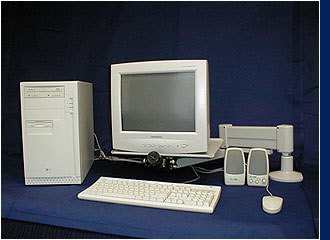
Acquisition of subject’s eye movement during the exploration
of the graphical interface is made by using a videooculographic device
(EyeGaze, LC Technologies Inc., Fairfax, Virginia).
 The EyeGaze is a “remote” system composed of a video camera
mounted below the computer screen, and a video monitor allowing to control
that the subject’s eye is focused and centred within the camera field.
The system uses the Pupil-Centre/Corneal-Reflection (PCCR) method to determine
gaze direction. A small infrared light emitting diode illuminates the
eye and generates a very bright reflection on the cornea. This effect
enhances the camera’s image of the eye and is used by the image processing
algorithms to locate the centre of the pupil. The software calculates
the co-ordinates of gaze position based on the relative positions of the
pupil centre and corneal reflection within the video image of the eye.
The basic feature of the system is that no contact exists between the
recording device and the subject and therefore no discomfort is caused
even by very long acquisition sessions. The EyeGaze is a “remote” system composed of a video camera
mounted below the computer screen, and a video monitor allowing to control
that the subject’s eye is focused and centred within the camera field.
The system uses the Pupil-Centre/Corneal-Reflection (PCCR) method to determine
gaze direction. A small infrared light emitting diode illuminates the
eye and generates a very bright reflection on the cornea. This effect
enhances the camera’s image of the eye and is used by the image processing
algorithms to locate the centre of the pupil. The software calculates
the co-ordinates of gaze position based on the relative positions of the
pupil centre and corneal reflection within the video image of the eye.
The basic feature of the system is that no contact exists between the
recording device and the subject and therefore no discomfort is caused
even by very long acquisition sessions.
|
